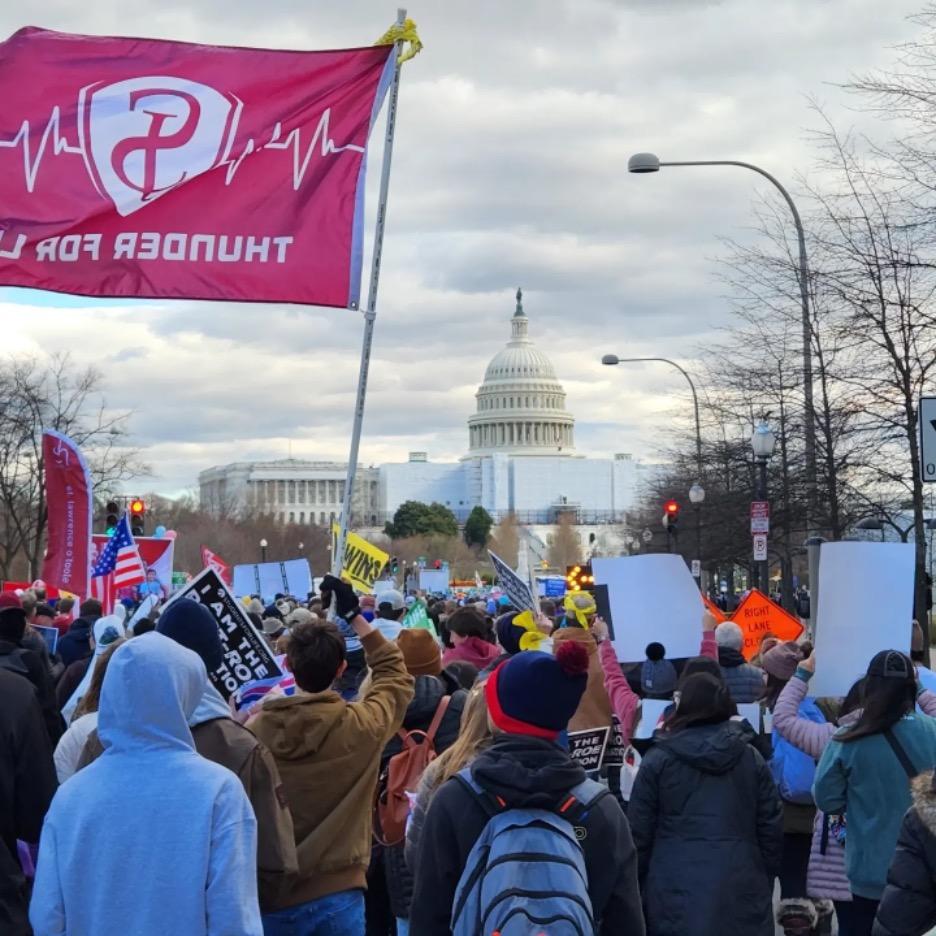(Photo by Johnathan Kreinberg)
On January 22, 1973, the Roe v. Wade and Doe v. Bolton decisions were handed down, legalizing abortion across the United States of America during the first and second trimesters of pregnancy. A later decision, Planned Parenthood v. Casey, adjusted the two-trimester standard to one of viability, which allowed states to prohibit abortion in cases where a baby could survive if born prematurely. However, there are large disparities in viability based on access to healthcare services, especially regarding geographic region and socioeconomic status.
Roe v. Wade was never accepted by everyone in the nation, and calls for its overturn began the same year. Since 1974, besides the COVID-19 pandemic years, hundreds of thousands of pro-life advocates have descended upon the District of Columbia annually, in protest of what they see as the murder of over 60 million people since the Roe v. Wade decision was handed down. In 2010, a Washington Post columnist noted that about half of those attending the march were under 30, which stands in stark contrast to the stereotype that the pro-life movement is primarily made up of old men who want to restrict women’s rights.
NJIT students attended the 2023 March for Life on Friday, Jan. 20, two days before what would have been the 50th anniversary of Roe v. Wade if the decision had not been overturned. NJIT fourth-year student and industrial engineering major Hannah Cherrey said, “I’ve gone to the March for Life multiple times in the past, showing support for the protection of life from conception to natural death. This time around, I also came to celebrate the big achievement, which is the overturning of Roe v. Wade.”
She commented, “While there is still work to do, this was the original reason the March for Life came about, and I can only imagine how accomplished marchers who have been there since the beginning must feel.” The event began with a rally at 12 p.m., followed by the official march at around 1:30 p.m. Starting from the Washington Monument, protesters walked to the road between the Capitol and the Supreme Court.
The lineup of speakers at the rally included people from various backgrounds, including a doctor, a New Jersey state representative, and actors. They shared experiences of keeping an unexpected child or adopting children. Cherrey added, “The crowd was also very diverse. Even though the media sometimes frames the pro-life movement as one made up of a specific demographic, that is far from the case. Young and old people, men and women, and religious and non-religious people were all present at the march.”
Marches can be important for various reasons, including the opportunity to connect with others who share the same views. Being with other people who are fighting for the same cause can help protesters feel stronger in their beliefs. In terms of making progress, being physically present to make one’s voice heard shows lawmakers that a movement is not one which can easily be ignored. Over time, with consistent effort, marches can indeed lead to change, with countless examples both in the United States and around the world.
Jonathon Kreinberg, a first-year electrical engineering graduate student who attended the March for Life, commented, “March for Life was an experience like no other. Often in environments I am used to, it is common for people who hold similar pro-life views as me shying away due to social pressures. March for Life was different. It was a place where we could all breathe and freely express what we believe without such pressures.”
Kreinberg spoke about the diversity in the crowd, saying that he saw “people of all backgrounds, young and old, children with joyful smiles, and even some elderly people who had trouble walking but still showed up. It felt like we were all united by love, like a big family fighting for the protection of innocent lives and celebrating the institution of the family.”
“During the end of the march,” Kreinberg recalled, “there was some opposition by the court building involving protestors yelling against the cause, but the marchers remained collectively peaceful. They kept holding their signs, singing hymns, saying group prayers, playing instruments, remaining united, and finding true joy in one another.”
Many in the NJIT community do not share this view. Anousha Raina, a fourth-year management and finance major, attended a 2017 Women’s March in New York City. She explained, “There were tons of diversity in gender, race, and even what each person represented; there were college students, protest groups, older women, families that brought their children, people in the alternative scene, and reporters. It was about equal laws for men and for women, and abortion is an equal law.”
On her personal experience, Raina commented that she shifted her focus to combating issues from a business perspective rather than politically. “I may not be impacting America,” she said, “but I am impacting the people around me. I have started several advocacy clubs on campus, including Advocates for Sexual Health Awareness. I’m lucky to be a part of a family that sees me as equal to my brothers and sees all women as equal to men.
“Kudos to the women that went to the Women’s March, kudos to the women that did not go, and kudos to all women: regardless of where you are from or what your family believes in, these are issues that you face as a woman.”
2023 marked the first March for Life since the Supreme Court decision Dobbs v. Jackson overturned the precedent of universal legality of pre-viability abortions set by Roe v. Wade, Doe v. Bolton, and Planned Parenthood v. Casey. Although the setting of the Roe v. Wade decision was what created the March for Life, and to a large extent the pro-life movement, Dobbs v. Jackson did not cause the movement to dissipate.
Likewise, though the Women’s March started as a response to the election of Donald Trump, it has persisted after his tenure, with its attendants dissatisfied with what they see to be inequities in America. Many pro-life activists say their goal is to make abortion not just illegal, but unthinkable. After all, if life truly starts at conception, and therefore embryos and fetuses are indeed persons, crossing the Texas-New Mexico border in a Greyhound would not make killing them acceptable. Conversely, if abortion is essential healthcare, it would be unacceptable to refuse that to women in many states.
No matter one’s opinion on the matter, policies will be shaped in the years to come, largely by members of Gen Z; it is inspiring to see NJIT students stand up for causes that they feel so passionately about.





























